Sphinginae subfamily
Sphingini tribe:
 |
Agrius cingulata, WO Pink-spotted hawkmoth,
possible stray: Strong migrant; adults nectar from
deep-throated flowers including moonflower (Calonyction aculeatum),
morning glory (Convolvulus), honey suckle (Lonicera), (Petunia species).
|
 |
Ceratomia amyntor BAMONA, Elm Sphinx, Four-horned Sphinx:
Brown with dark brown, white markings including white costal area near wing base, dark
streaks along veins, white spot in cell. Elm (Ulmus), birch (Betula), basswood (Tilia), cherry (Prunus). |
 |
Ceratomia catalpae WO, Catalpa Sphinx:
Yellowish brown with no white markings, indistinct black lines and dashes. Cell spot gray with black outline; hindwing: yellowish brown with obscure lines.
Catalpa . |
 |
Ceratomia hageni WO, Hagen's Sphinx, Osage Orange Sphinx:
Gray with green tint; dark indistinct wavy lines, pale gray patches at wing tip and
along costa. generally a more southerly species; unlikely |
 |
Ceratomia undulosa WO, Waved Sphinx:
Pale brownish gray (sometimes dark) with wavy black and white lines, black-outlined white cell spot. |
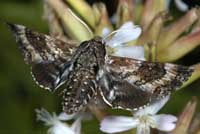 |
Dolba hyloeus WO, Pawpaw Sphinx:
Dark brown with a dusting of white scales. Some moths have patches of reddish or yellowish brown on the
wings. Larve are not limited to pawpaw.
|
 |
Lapara bombycoides WO, Northern Pine Sphinx:
Gray with heavy black bands. Hw: brownish gray with no markings. If you have pines, you might have this species.
|
 |
Lintneria eremitus WO, Hermit Sphinx:
The upperside of the forewing is gray-brown with wavy lines, black dashes, and
one or two small white spots near the center of the costa.
|
 |
Manduca jasminearum WO, Ash Sphinx:
Gray to grayish brown witha black line running from middle of costa to middle of outer
margin; line may be broken near margin. Splash of brown around cell spot.
|
 |
Manduca quinquemaculatus WO, Five-spotted Hawkmoth:
Flies in tobacco fields and vegetable gardens (potatoes, tomatoes) and wherever host plants are found. |

|
Manduca sexta BAMONA, Carolina Sphinx:
Hw upperside banded with black and white and has
two black zigzag median lines that are very close together with
hardly any white showing between them. Larvae can strip tomato plant.
|
 |
Neococytius cluentius, WO Cluentius sphinx:
unlikely stray, but possible
Blurry black with orange markings. Hw upperside: black with orange at base and orangish yellow patches between veins,
forming a band across wing.
|
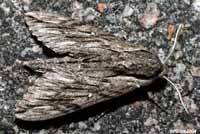 |
Paratrea plebeja WO, Plebeian Sphinx: Gray with indistinct black and
white markings. Series of black dashes from the base to the tip, and a small white cell spot.
|

|
Sphinx canadensis
WO, Canadian Sphinx: Uncommon, not often reported anywhere,
but it might possibly be present.
Larval hosts are white ash (Fraxinus americana) and blueberry
(Vaccinium). unlikely
|
 |
Sphinx chersis WO, Northern Ash Sphinx, Great Ash Sphinx:
Soft dark gray to blue-gray with series of black dashes, one of which reaches wing tip. |
 |
Sphinx drupiferarum WO, Wild Cherry Sphinx:
Forewings, long and slender, held close to body when moth is at rest. We have them on P.E.I., but I do not see them nearly as frequently as I see the other Sphingidae. |
 |
Sphinx gordius WO, Apple Sphinx:
Colouration and markings highly variable. Fw fringes mostly black with some white; those on hw mostly white with few black patches.
|
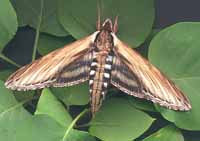 |
Sphinx kalmiae WO, Laurel Sphinx:
Lower fws predominantly brownish-yellow with fairly wide dark bar along inner margin. At rest wings hug body, giving the moth long slender look.
|
 |
Sphinx luscitiosa WO, Canadian Sphinx, Clemen's Sphinx:
Yellowish gray in males and pale gray with faint yellow tint in females. Dark
border on the outer margin widens as it approaches inner margin.
|
 |
Sphinx poecila WO, Poecila Sphinx:
If you have blueberries, then you probably have poecila. Outer wing fringes checkered black and white on dark grey fw, almost pure white
(lightly checked with grey) on hw. White forewing cell spot. |
Smerinthini Tribe:
 |
Amorpha juglandis WO, Walnut Sphinx:
Highly variable; sometimes wings may be all one color or may have several colors, ranging from pale to
dark brown, and may have a white or pink tinge.
Female is different. |
 |
Paonias excaecata BAMONA, Blinded Sphinx:
Fw outer margin quite wavy. Dark cell spot and dark oblique line mid wing from costa almost to
inner margin. Basic ground colour is pinkish brown. Flight would be June-July. |
 |
Paonias myops WO, Small-eyed Sphinx:
This small species is probably widespread and common. This species ranges across North America.
The hindwings have a small blue eyespot ringed with black on a yellow background.
|
 |
Pachysphinx modesta WO, Modest Sphinx, Poplar Sphinx:
This moth has a large, heavy body, and females can be remarkably plump.
|
 |
Smerinthus cerisyi WO, Cerisyi's Sphinx, One-eyed Sphinx:
Flight would be from late May-July as a single brood.
Questionable, generally more northerly species
|
 |
Smerinthus jamaicensis WO, Twin-spotted Sphinx:
Note pale apical arc makes a complete "C", with lower point reacing outer margin.
Along the East Coast, it flies from P.E.I. to Florida.
|
Macroglossinae subfamily
Dilophonotini Tribe:
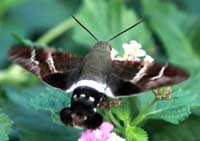 |
Aellopos titan WO, Titan Sphinx:
Body dark brown with wide white stripe across abdomen.
Wings dark brown. Hindwing has pale patches along costa and inner margin. rare stray |
 |
Erinnyis ello WO, Ello Sphinx:
Abdomen: very distinct gray and black bands. Female's fw pale gray with few dark dots near outer margin. Male's fw dark gray, brown with
black band running from base to tip. stray
|
 |
Erinnyis obscura, Obscure Sphinx:
WO, At night adults nectar at flowers, including bouncing bet
(Saponaria officinalis) and Asystasia gangetica beginning at dusk.
July- August flight times in southern states.
rare stray
|
See Hemaris comparison to help distinguish the next three species.
 |
Hemaris diffinis BAMONA, Snowberry Clearwing:
Flies along forest edges, in meadows, gardens,d
brushy fields. Day-flying adults nectar at lantana, dwarf bush honeysuckle,
snowberry, orange hawkweed, thistles, lilac, Canada violet, etc.
|
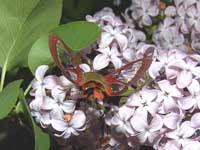 |
Hemaris gracilis WO, Slender Clearwing, Graceful Clearwing:
Distinguished from similar species by pair of
red-brown bands on undersides of thorax, which varies from
green to yellow-green dorsally, sometimes brown with white underneath. questionable
|
 |
Hemaris thysbe BAMONA, Hummingbird Clearwing:
They are widely distributed in the east from P.E.I. to Florida.
|
Philampelini Tribe:
 |
Eumorpha achemon USGS, Achemon Sphinx:
This moth is confirmed for McHenry County. It is fairly often reported along the east coast from southern New Jersey
to central Maine.
|
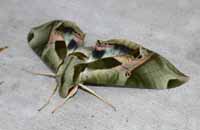 |
Eumorpha pandorus BAMONA, Pandorus Sphinx:
If you have Grape or Virginia Creeper nearby, then you probably have
this species. I often get asked to identify larvae from areas not previously been reported. |
Macroglossini Tribe:
 |
Amphion floridensis
BAMONA, Nessus Sphinix:
This day flier is widely distributed. If you have Virginia Creeper,
you probably have the Nessus Sphinx. Two bright, distinct, narrow
yellow bands are often visible on the abdomen.
|
 |
Darapsa choerilus WO, Azalea Sphinx:
You will often see this species listed as Darapsa pholus,
especially in older literature. Lower wings solid brownish-orange, matching body colour. |
 |
Darapsa myron WO, Virginia Creeper Sphinx, Grapevine Sphinx:
If you have the foodplants indicated in the common names, you probably have Myron.
Dark rectangular patch on the costal margin, may be reduced or absent. Hw: pale orange. |
 |
Darapsa versicolor WO, Hydrangea Sphinx:
If you have hydrangea growing near a stream, then you may have versicolor; uncommon.
Greenish-brown with curved dark lines, pinkish-white patches
|
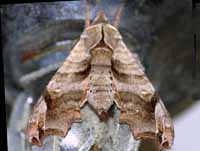 |
Deidamia inscriptum WO, Lettered Sphinx:
Fw outer margin deeply scalloped, light brown with dark brown markings.
Small black and white spot near tip. Hw: orange-brown with dark brown outer margin and median line.
|
 |
Hyles gallii WO, Bedstraw Hawk Moth, Gallium Sphinx:
Dark brown with slightly irregular cream-coloured transverse line. Outer margin grey. Bright pink hindwing band.
|
 |
Hyles lineata BAMONA/KC/GC, White-lined Sphinx:
Usually fly at dusk, during night, and at dawn, but also fly during the day over wide variety of open habitats
including deserts, suburbs, and gardens. |
Hyles lineata, Highland Park, September 3, 2013, Katherine and Guillermo Crespo.
 |
Sphecodina abbottii WO, Abbott's Sphinx:
Adults mimic bumblebees, buzzing when feeding. Wing margins scalloped.
Fw: dark brown with light brown bands, markings. Hw: yellow with wide black outer margin.
|
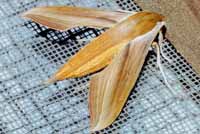 |
Xylophanes tersa BAMONA, Tersa Sphinx:
Pale brown with lavender-gray at the base and has dark brown lengthwise lines throughout.
Hindwing dark brown with band of whitish, wedge-shaped marks.
|
|
|




